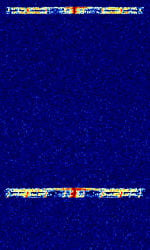End of Train Device (EOTD)
Not to be confused with EOTEnd of Transmission (end-of-transmission).
|
Transmits train telemetry such as brake status and accidental separation information to the head locomotive.
ETD devices monitor functions such as brake line pressure and accidental separation of the train using a motion sensor, functions that were previously monitored by a crew in the caboose. The ETD transmits the data via a telemetry link to the Head-of-Train Device (HTD) in the locomotive.
Characteristics[edit]
Uses 1200 baudBaud (unit symbol Bd) is the unit for symbol rate or modulation rate in symbols per second. FSKFrequency-Shift Keying.
Frequencies[edit]
ETD's in North America operate on the 452.9375/457.9375 MHzMegaHertz (MHz) 10^6 Hz frequency pair, with the EOTEnd of Transmission Device on the higher frequency and the locomotive engine on the lower.
Australia's Pacific National rail freight locomotives use 477.7 MHzMegaHertz (MHz) 10^6 Hz for EOTEnd of Transmission and 472.5 MHzMegaHertz (MHz) 10^6 Hz for HOT.
New Zealand operates on 450.2625 MHzMegaHertz (MHz) 10^6 Hz for both it's HOT and EOTD, due to the railway layout in New Zealand, a DPU is not used.
Decoding Software[edit]
- Hobby Level Software
Now on groups.io
- Attention Applicants: You will be sent a brief email questionnaire in order to establish intended use. Please check your spam folder if you don't receive it. ***
